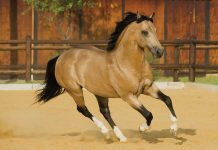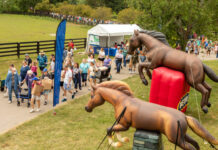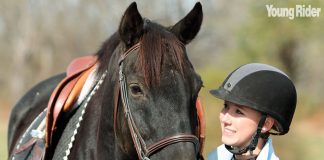Riding a lazy horse can be frustrating. It seems that all you do is squeeze, squeeze, and squeeze, with your lower legs while she ignores your every aid. A lazy horse has learned to do the least bit of work possible—and who can blame her. If she’s not asked to work properly, why should she!
We’ve got some tips to help you get that slow-poke moving!
Work on your position
Sit up straight on a lazy horse. Sit deeply and press both of your seat bones in the middle of the saddle.
Gather up the reins and keep a firm hold on them. Lift up your horse’s head by squeezing with your middle finger on both reins and taking some contact with his mouth. At the walk, squeeze with alternating legs to keep her moving forward briskly. If she slows down, give her a quick poke with both of your ankles. Wake her up!
Your calves should always touch her sides, but you shouldn’t squeeze non-stop. Why? Your horse will just ignore this constant pressure.
At the rising trot, squeeze with both legs every time you sit down.
If your horse isn’t too bumpy, do a bit of sitting trot during every schooling session. Sit to the trot for about 10 or 15 feet and then begin rising again.
Pay attention!
If your horse totally ignores your leg aids and refuses to move forward with energy, you’ll have to resort to “artificial aids” like the crop and, maybe, spurs.
Every time you ride, carry a fairly long crop in your inside hand. If your horse doesn’t move forward the second you ask her to with your legs, reach back with the crop and tap him firmly closely behind your lower leg on his side. What you’re telling him is: if you don’t listen to my leg, you are going to get tapped with the crop.
Don’t waste time tapping her on the shoulder with the crop. It doesn’t do anything. It’s ineffective. Your horse’s power comes from her hindquarters, so you must engage them instantly if you want to move forward with impulsion.
Your leg aids can also be reinforced by spurs, but don’t strap on a pair if you’re new to riding. Spurs should only be used by kids who have been riding a while and who have quiet, secure lower legs. This is because spurs can do a lot of damage if they aren’t used properly. They can hurt a horse’s side and leave nasty scars.
If your trainer thinks you’re ready for spurs, invest in a pair of short, fairly blunt spurs until you know how to use them. Tom Thumb spurs or Prince of Wales spurs are great for young riders and they can be used effectively on a lazy horse.
If you wear spurs, keep your calves close to your horse’s side and make sure you are not poking her by mistake. The spurs should only touch her sides when you need them to urge her forward. If she ignores your legs, turn your heels in slightly and give her a slight poke with the spur tips.
It’s very important to never lose your temper with your horse and jab her roughly with the spurs. White scars on a horse’s sides are a sure sign that she’s been spurred severely. No horse should have to suffer this sort of treatment!
Transitions
A surefire way to rev up a lazy horse is doing lots and lots of transitions. Transitions are simply a change of gait or pace. Going from walk to trot is a transition; so is going from trot to canter. Jazz up your schooling sessions by going from trot to halt or walk to canter. Never let your horse predict what you’re going to ask her next. Go from canter to halt and then ask your horse to back up and halt. Then, ask her to trot immediately from the halt.
Try to make the transitions as smooth as possible. When you ask your horse to trot, she should trot right away. It shouldn’t take three minutes of kicking. Use the crop right away behind your lower leg if necessary. You might shock your horse the first two or three times, but she should react more quickly the fourth time you ask her to move forward!
Get out of the arena
All lazy horses benefit from escaping the arena once in a while. If you’ve got trails around your barn, grab a friend and go out for a ride. If your horse is safe and well behaved, you can trot and canter with your friend out on the trail.
If you don’t have trails, ride your horse around an empty field. Get in galloping position and have a nice, long canter out in the open. Mixing it up like this will freshen up your horse for working in the arena. Try to get out of the arena at least once a week. Riding out in the open will help improve your skills in the saddle too.
Riding out in fields or on the trails will also help improve your horse’s fitness, and once she’s a bit stronger, she may be less lazy in the arena.
Go somewhere different and try something new!
Your lazy horse will benefit from being put in a trailer and taken somewhere where he can experience new places and participate in new, fun activities. Hitch a ride with a friend to a horse park where you can ride out in the open and pop over a few small cross-country fences. Splash through a creek! Sign up for a clinic at another barn. If hunter paces are held in your area, ask a friend to do one with you. Take your horse with you to riding camp.
You can also try another equestrian sport. If you normally compete in hunter shows, enter a dressage competition. And you don’t have to join a group or have a zippy pony to do mounted games with your pals at the barn. Just set up a mounted games afternoon and decide which games you want to play.
Finally, if your horse is quiet, take off your saddle and ride bareback once in a while. Make life less boring for your horse and she’s sure to be less lazy—and riding her will be more fun for you!





